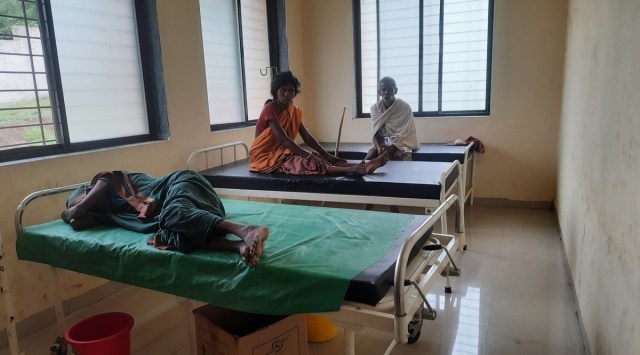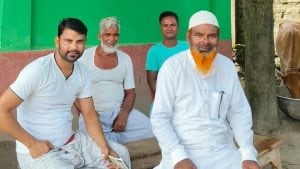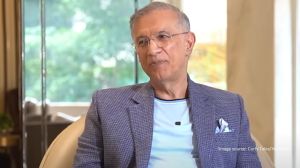Rs 6-crore Bilgaon PHC has no electricity, patients treated under torchlight
The story is the same across the entire belt as most new PHCs around Dhadgaon do not have facilities.
 Doctors often treat patients with the help of sunlight coming through the open windows. (Express photo by Rupsa Chakraborty)
Doctors often treat patients with the help of sunlight coming through the open windows. (Express photo by Rupsa Chakraborty) In the last two years, Nandurbar district has set up 11 newly-designed advanced primary health centres (PHCs). Worth Rs 6 crore each, each PHC is spread over 3,000 sq ft with a doctors’ quarter. However, the condition of these PHCs – meant to provide healthcare to the poorest and weakest sections of Nandurbar’s tribal population – is abject.
One such PHC is the Bilgaon facility inaugurated in 2021. A year down the line, the centre still lacks basic health infrastructure like electricity.
It has forced men like Dr Ravindra Pawra, the medical officer of the PHC, to treat patients under the light of a torch. The centre also keeps its vaccines in other PHC centres.
 Patients waiting in dark due to load shedding.
Patients waiting in dark due to load shedding.
Bilgaon is located on a hilly slope near the Narmada backwater, situated 104 km away from sub-district headquarter Dhadgaon. The PHC caters to 11 villages with a population of 14,221.
In 2010, the Directorate of Health Services had constructed a two-room fibre structure as a PHC worth Rs 25 lakh in Bilgaon. Later, the advanced PHC was constructed opposite to the old one. It has six quarters for health workers and two quarters for medical officers so that the team is available round-the-clock to attend to emergencies.
But when The Indian Express visited the centre, it found patients waiting in the dark corridors and doctors treating patients with the help of the sunlight coming through the open windows.
 The cold temperature of vaccines are being maintained with batteries which last only for six hours.
The cold temperature of vaccines are being maintained with batteries which last only for six hours.
On September 23, when Wadhi Gojmal, a tribal woman from Chikhali village, reached the PHC after walking 3 km, she was immediately admitted to the emergency room. She was suffering from nausea, vomiting and fever.
Dr Pawra prescribed intravenous saline. But finding her vein to insert the IV needle was difficult in the dark room.
The issue was taken up by a state-appointed core committee – formed in 2018 in response to a petition filed before the court by activist Bandu Sampatrao Sane regarding malnutrition in tribal areas. The committee annually addresses issues of nutrition among children and mothers in 16 districts of the state with high tribal populations.
In her reply to the committee, District Collector Manisha Khatri, in a written submission, said that the villages served by Bilgaon PHC are hard to reach. “To tackle the problem of water supply, a separate water source has been created… solar back-up electricity facility has been installed and is in working condition,” read the letter.
However, during monsoon, the solar panels fail to provide electricity. “At night, we treat patients with the help of torches. We also to fear snake bites when we sleep in the quarters,” said Dr Pawra.
On a daily basis, the PHC witnesses powercuts for 2-3 hours. On days when the powercuts stretch over 12 hours, the staffers transfer vaccines to other PHCs, as the centre has a battery back-up of six hours to maintain vaccines in the freezer.
“We have no other option but to transfer the vaccines to other PHCs where there is electricity. When power returns, we bring the vaccines back. During transportation also, we have to ensure that the cold chain of the vaccines are maintained,” said Dr Pawra.
The Dhadgaon taluka has the most number of malnourished children in Nandurbar. During the monsoon screening in June-July, cases of malnutrition in the district stood at 14.61 per cent. Data showed that of the 1,60,504 children who were screened in the 0-6 years age group, 3,554 or 2.21 per cent were found to be Severe Acute Malnutrition (SAM). Also, 19,961 or 12.4 per cent of them were detected with Moderate Acute Malnutrition (MAM). Among them, 5,166 children were from Dhadgaon.
Considering the isolated and difficult terrain of Bilgaon, where cellular networks are not available, the health department had constructed a 10-bed nutrition rehabilitation centre (NRC) inside the Bilgaon PHC.
The SAM children from the neighbouring villages were supposed to be referred to the NRC for treatment and nutrition supplements. But the NRC has been lying unused because the ceiling fans had been stolen. “The fans were stolen even before the PHC was handed over to us. We can’t start the NRC until fans are installed. We have sought retendering for installation of fans,” said Dr Pawra.
Asked about the deplorable condition of the new PHC, District Health Officer Dr Govind Chaudhary said they have installed solar panels to deal with powercuts. “The PHC is situated in the remotest part where electricity is an issue. We are trying our best to provide best possible solutions… We are in the process to install more batteries, which will be able to provide electricity from the stored solar energy in the PHC,” he said.
Latika Rajput, a member of the Narmada Bachao Andolan and also the government-appointed core committee, said, “When the centre was inaugurated, a tanker supplied water to it. Then, for over a year, there was no water. After we raised the issue, water supply started in September. Now, there is no regular electricity supply.”
“If any pregnant woman comes to the centre for delivery, the doctors won’t be able to do it without water and electricity,” she added. Thus, most women opt for home deliveries around the area.
Moreover, within two years of its construction, the ceilings and plasters of the quarters have started falling off. The centre doesn’t even have an Internet connection, which hindered the immunisation programme against Covid-19. The staffers had to travel to Dhadgaon to register the data of the beneficiaries on the Co-WIN app. Also, the centre has one ambulance, which often malfunctions. The staff complained that sometimes it takes months to be repaired. “I have worked in many tribal dominated districts, including Gadchiroli and Chandrapur, but the experience here is quite different, ” said Dr Pawra.
The story is the same across the entire belt as most new PHCs around Dhadgaon do not have facilities. Rajput described the conditions as “inhuman and a violation of the right to life”.







